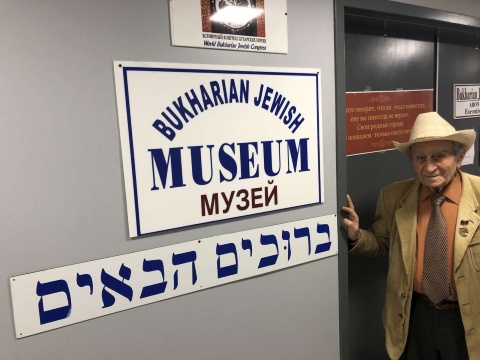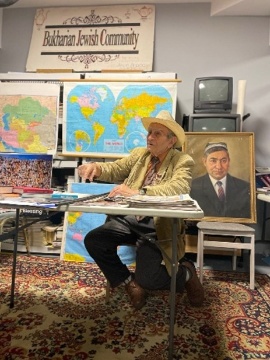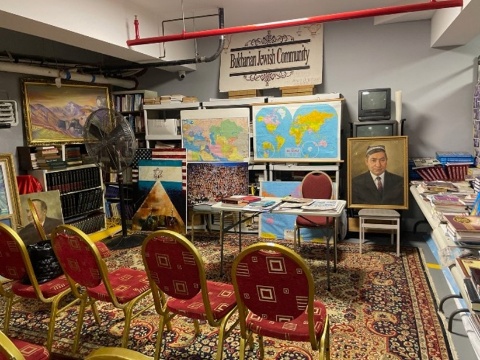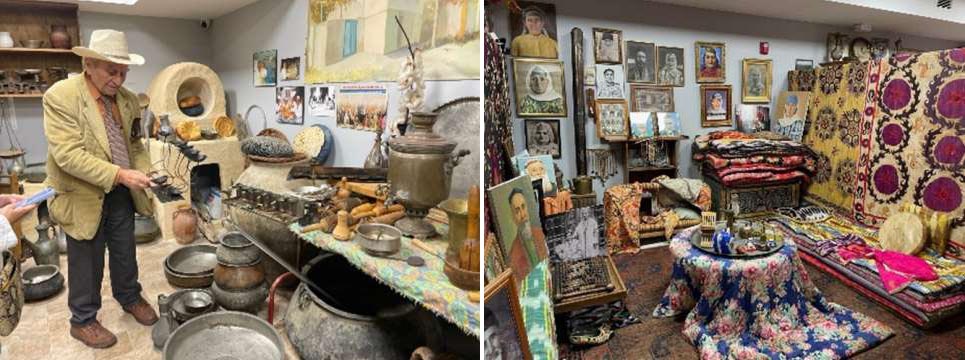As part of our field and archival research in New York in November 2024, we explored the religious and cultural institutions of the Bukharan Jewish community in the city. One important institution in this effort was the Bukharan Jewish Museum, located in Rego Park, Queens.

Image 1. Aron Aronov in front of the entrance to his museum (New York, Nov 2025)
The museum was founded by Aron Aronov (*1938), who emigrated from Tashkent to New York in the early 1990s. Here, the trained interpreter began to collect artefacts of Jewish life and history in Central Asia. Aronov founded the museum with the aim of preserving the history and cultural identity of the community. He wanted to ensure that future generations, especially those born in the USA, would remain connected to their heritage and prevent the possible loss of their traditions.
The museum is in the heart of Bukharan Jewish New York, in an underground car park provided by a young Bukharan Jewish entrepreneur. After making an appointment by phone, we found Aronov and his daughter Alla waiting for us in front of his museum. A small lecture theater has been set up in a room next to the exhibition itself. Here, visitors are given a first introduction to the topics of the Bukharan Jews, Central Asia and the Soviet Union. (Images 2–3).


Image 2 & 3. Aron Aronov in the lecture hall of his museum (NY, Nov 2025).
The museum has an extensive collection covering many aspects of the daily life of the Bukharan Jewish community in Central Asia. It includes material culture and everyday artefacts such as traditional clothing and textiles (costumes, fabrics and embroidery), household items (cooking utensils and pottery), and various objects related to art and culture.
The items on display were collected and acquired by Aron Aronov from Bukharan, Mashhad, and Afghan Jews who had emigrated to the USA, as well as during his annual trips to Central Asia. The museum is set up as a Soviet-style ethnographic museum, taking the visitor through various aspects of the lives of Central Asian Jews. The exhibition features almost no written explanations. They are not necessary, as Aron Aronov (usually accompanied by his daughter Alla) personally guides visitors through the museum, which covers topics from everyday life in a traditional Jewish home (with indoor and outdoor areas; images 4–5) to the life of a wealthy entrepreneurial family with a European-style room (with a gramophone and sewing machine; images 6–7). After an exhibit on the role of women, there are displays depicting various stages of Soviet history, with a section dedicated to the Great Patriotic War that focuses on the contribution of Bukharan Jewish soldiers to the Red Army's struggle and eventual victory.
 Image 4 & 5. Bukharan Jewish Museum, New York (Nov 2024).
Image 4 & 5. Bukharan Jewish Museum, New York (Nov 2024).
 Image 6 & 7. Bukharan Jewish Museum, New York (Nov 2025).
Image 6 & 7. Bukharan Jewish Museum, New York (Nov 2025).
Additionally, the collection contains handwritten and printed books, marriage certificates, and photographic collections that document the community’s history and migration over time. A small part of the collection comprises historical documents, including sacred and secular texts and manuscripts, many of which were handwritten in the 19th and 20th centuries or printed in the early 20th century. Furthermore, a collection of personal photographs depicts the past and present of families in Central Asia and their daily lives in New York, providing a visual narrative of their heritage and endurance.


